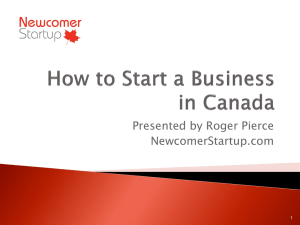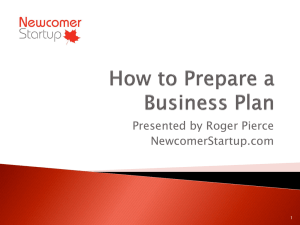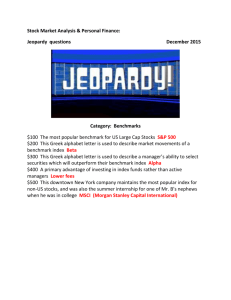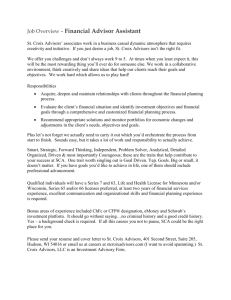Bruce Wright - The Wright Company
advertisement
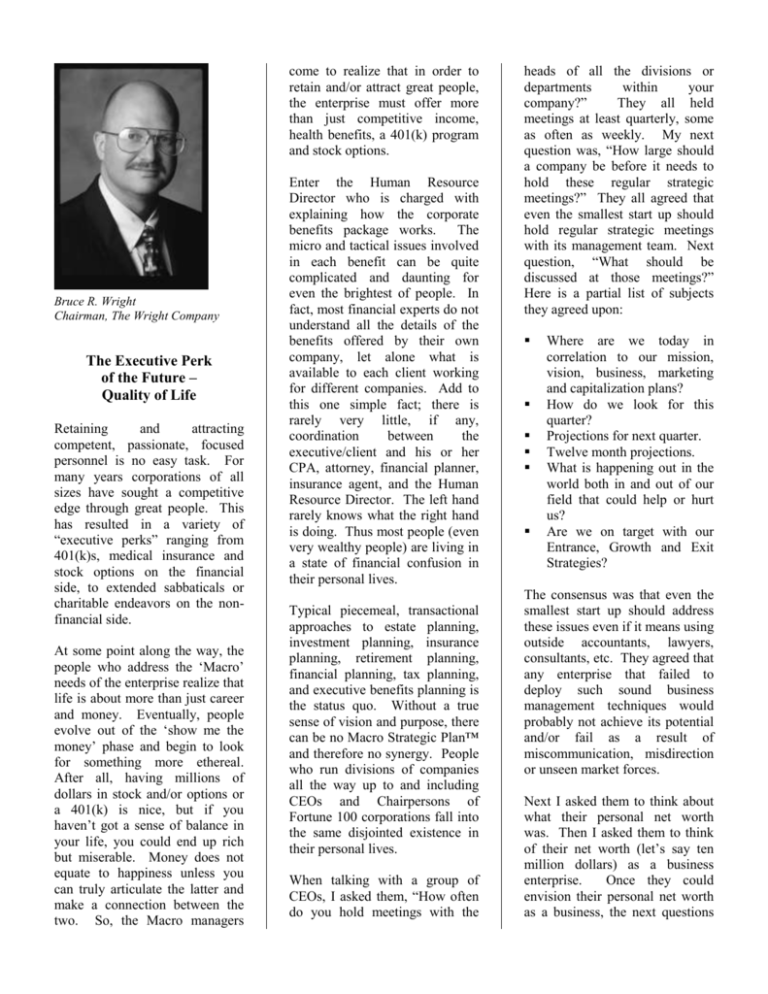
come to realize that in order to retain and/or attract great people, the enterprise must offer more than just competitive income, health benefits, a 401(k) program and stock options. Bruce R. Wright Chairman, The Wright Company The Executive Perk of the Future – Quality of Life Retaining and attracting competent, passionate, focused personnel is no easy task. For many years corporations of all sizes have sought a competitive edge through great people. This has resulted in a variety of “executive perks” ranging from 401(k)s, medical insurance and stock options on the financial side, to extended sabbaticals or charitable endeavors on the nonfinancial side. At some point along the way, the people who address the ‘Macro’ needs of the enterprise realize that life is about more than just career and money. Eventually, people evolve out of the ‘show me the money’ phase and begin to look for something more ethereal. After all, having millions of dollars in stock and/or options or a 401(k) is nice, but if you haven’t got a sense of balance in your life, you could end up rich but miserable. Money does not equate to happiness unless you can truly articulate the latter and make a connection between the two. So, the Macro managers Enter the Human Resource Director who is charged with explaining how the corporate benefits package works. The micro and tactical issues involved in each benefit can be quite complicated and daunting for even the brightest of people. In fact, most financial experts do not understand all the details of the benefits offered by their own company, let alone what is available to each client working for different companies. Add to this one simple fact; there is rarely very little, if any, coordination between the executive/client and his or her CPA, attorney, financial planner, insurance agent, and the Human Resource Director. The left hand rarely knows what the right hand is doing. Thus most people (even very wealthy people) are living in a state of financial confusion in their personal lives. Typical piecemeal, transactional approaches to estate planning, investment planning, insurance planning, retirement planning, financial planning, tax planning, and executive benefits planning is the status quo. Without a true sense of vision and purpose, there can be no Macro Strategic Plan™ and therefore no synergy. People who run divisions of companies all the way up to and including CEOs and Chairpersons of Fortune 100 corporations fall into the same disjointed existence in their personal lives. When talking with a group of CEOs, I asked them, “How often do you hold meetings with the heads of all the divisions or departments within your company?” They all held meetings at least quarterly, some as often as weekly. My next question was, “How large should a company be before it needs to hold these regular strategic meetings?” They all agreed that even the smallest start up should hold regular strategic meetings with its management team. Next question, “What should be discussed at those meetings?” Here is a partial list of subjects they agreed upon: Where are we today in correlation to our mission, vision, business, marketing and capitalization plans? How do we look for this quarter? Projections for next quarter. Twelve month projections. What is happening out in the world both in and out of our field that could help or hurt us? Are we on target with our Entrance, Growth and Exit Strategies? The consensus was that even the smallest start up should address these issues even if it means using outside accountants, lawyers, consultants, etc. They agreed that any enterprise that failed to deploy such sound business management techniques would probably not achieve its potential and/or fail as a result of miscommunication, misdirection or unseen market forces. Next I asked them to think about what their personal net worth was. Then I asked them to think of their net worth (let’s say ten million dollars) as a business enterprise. Once they could envision their personal net worth as a business, the next questions really struck home. How often do you hold meetings with the various division managers of your personal enterprise? The truth is that none of them had ever held a meeting with their lawyer, accountant, financial advisors, etc., all together to discuss the subjects listed earlier. Some couldn’t even imagine getting all of their advisors into a meeting at the same time. For the most part, their advisors didn’t know one another, had rarely if ever spoken to one another and none of them had ever coordinated anything with the Human Resource Director where the CEOs worked. This exemplifies the piecemeal, transactional, disconnected behavior of the otherwise brilliant business people. Knowing better but neglecting to apply sound business management to ones own personal enterprise is totally preventable. What is worse is that many ‘advisors’ lack the proactivity, perspective and skills to work together in synergistic ways to achieve the best results for their executive clients. There is nothing prohibiting these advisors from contacting each other or the HR Director. However, the HR Director is rarely if ever authorized to proactively engage the executives other advisors. The status quo is not any one person’s, industry’s or profession’s fault. It’s the cultural norm. It is ‘The Box’ in which executive perks, retirement plans, estate planning, tax planning, investment allocation advice, and financial planning, etc., are most easily provided or sold. It is the path of least resistance and requires lesser skills, effort and proactivity. There is an old tale from India which tells of a wise Rajah who wanted to study an important part of human nature. The Rajah gathered six blind men together and asked them to define a newly discovered animal by touch. Since each of the men had been blind since birth, they had never seen such an animal. To make certain the men would not be prejudiced by previous descriptions they may have heard, they were told nothing about the animal. comprehend the whole elephant.” This story exemplifies the essence of macro or big picture thinking and vision vs. the piecemeal behavior of the majority of advisors, their clients and companies. Each blind man was assigned to a different part of the animal and allowed to touch only that portion of the creature to which he was assigned. The first man touched his part and said, “This animal is like a spear.” The second man felt his portion and declared, “This animal is like a snake.” Feeling the ear, the third man exclaimed, “This animal is like a fan.” The fourth man stroked the animal’s front leg and announced, “This animal is like a tree.” The fifth man after patting the creature’s side decided, “This animal is like a wall.” Finally, the sixth man grasped the tail and proclaimed, “This animal is like a rope.” In some ways, we can all be like the blind men. Trying to get an accurate perspective of or find the truth in life, finance, etc., can be very difficult, especially if we are too close to the problem. Often true perspective and full knowledge are gained only when we step back from a situation and try to look at it from all angles. In order to do this effectively, we often need help for several reasons. First, when it’s about us or our situation, and the closer we are to an issue, the more emotional we tend to be. The more emotional we become, the less objective we are. Secondly, we cannot be experts in everything important to our success. We don’t know what all the angles are or everything to look for. Thus, we need an interdependent mindset and thirdparty help to accurately perceive and overcome these obstacles. The six blind men began arguing over who was right and who was wrong. Because each of these men had an ego and pride, as most of us do, the argument became quite heated. At this point, the wise Rajah who had set up the exercise stepped in and said, “The elephant is a large animal, made up of different parts. Each of you has knowledge of only one part. To find out the whole truth, you must gain knowledge of all the parts and put them all together. In order to do this, you must set aside your ego and pride to realize you may not have all the knowledge necessary to I have spent a lot of my time over the last several years educating lawyers, accountants and the myriad of financial advisors how to break out of the box by bringing macro vision, true meaning and value to clients. Less than 10% of the advisors who have heard my message actually change their behavior and break out of the status quo. Conversely, nearly 90% of the multi-millionaire clients who encounter the message embrace it and take action. It seems to come down to whether or not the advisors are transactionallycentered or macro client-centered. Unfortunately, most are too busy with life and trying to make a living so they choose the path of least resistance and will not change to a macro client-centered format. Seeing ourselves and our employees as ‘elephants’ or as total beings with a variety of issues to address is not easy. If we surround ourselves with ‘advisors’ who choose not to address our needs with macro vision, synergy and solutions, we cannot become all we are capable of. The status quo approach of piecemeal, transactional ‘inside the box’ planning actually produces chaos and impedes the likelihood of becoming an elephant. Such typical behavior fails to address the truly crucial and dynamic issues relevant to our total success and happiness. Relevant questions such as: How much is enough? When is it enough? If you could wave a magic wand and create the perfect calendar, what would it look like? If you could spend your time, talent and wealth doing exactly what is most fulfilling and rewarding, what would go on that perfect calendar? If your net worth is large enough, what is stopping you from living the perfect calendar now? What needs to change? If your net worth isn’t already large enough to be financially independent, what should you do now to get there within a reasonable time frame? The true essence of what I call Macro Strategic Planning™ addresses all of the above. Addressing who you really are, what is really important to you and how to make sense of it all is vastly superior to status quo models. The fact that so many companies and professional advisors choose to deal with only a piecemeal part of the elephant rather than take a macro synergistic approach is what creates the great opportunity. Many companies make efforts to motivate and uplift their employees. I have sat in on many entertaining and motivational speeches. However, ex-athletes, politicians and motivational authors and speakers often fail to get to the truly core issues. As a result, the audience is generally unable to retain or apply the conceptual ideas offered by most speakers. The truth is, at the end of the program most people feel better but they aren’t actually any better off. The company, having spent tens of thousands of dollars, perhaps more, feels that it has done something to show it cares. Exciting concepts and entertaining speeches are nice, but substantive personal application and practical implementation are far superior to even the most heart-warming speech. Real substantive action, the kind that achieves genuine life fulfilling results is far more valuable than anything an ex-quarterback, retired general or politician has to offer. If you believe that doing is more important and valuable than talking, you know what I mean. Those companies that continue to invest time and money presenting ineffectual motivation and money-centered tactics will be run over by competitors delivering sound, practical, life enhancing solutions. Innovate or die is such a common phrase that in certain industries it has almost become passe. Yet the truth is: People and companies do what they want to do when they want to do it. Much of the time important, even critical issues are procrastinated because the status quo is more comfortable than change. The subject matter discussed in this article is most assuredly challenging to the status quo behavioral patterns of many individuals, couples, businesses, human resource departments and the bevy of advisors mentioned earlier. Isn’t it interesting that even the most innovative high tech companies seem stranded in 1980s and 1990s piecemeal, transactional, tactical ‘executive perks’? Companies that choose to ignore this innovative opportunity to get on the cuttingedge of caring for their employees will lose their best and brightest to the competition. The competitive edge will go to companies that engage in ‘elephant building’ and focus on balancing and improving the quality of life for all employees. Retaining and attracting the caliber of people essential to success is a lot easier when employees feel that the employer is addressing their greatest needs. How easy is market dominance in this arena today? Who will assume dominance in your industry and when? These are the salient questions for every company to answer now, while the window of opportunity is still open. Bruce Wright’s dynamic business strategies have been successfully implemented by financial services professionals and wealthy consumers across the country. His book, The Wright Exit Strategy – Wealth; How To Create It, Keep It and Use It, is being endorsed by industry leaders and wealthy consumers alike as the visionary guide to Macro Strategic Planning. Additional information on Bruce Wright and The Wright Company may be found at: www.thewrightco.com or by calling 1-800-997-2664. 6/99
